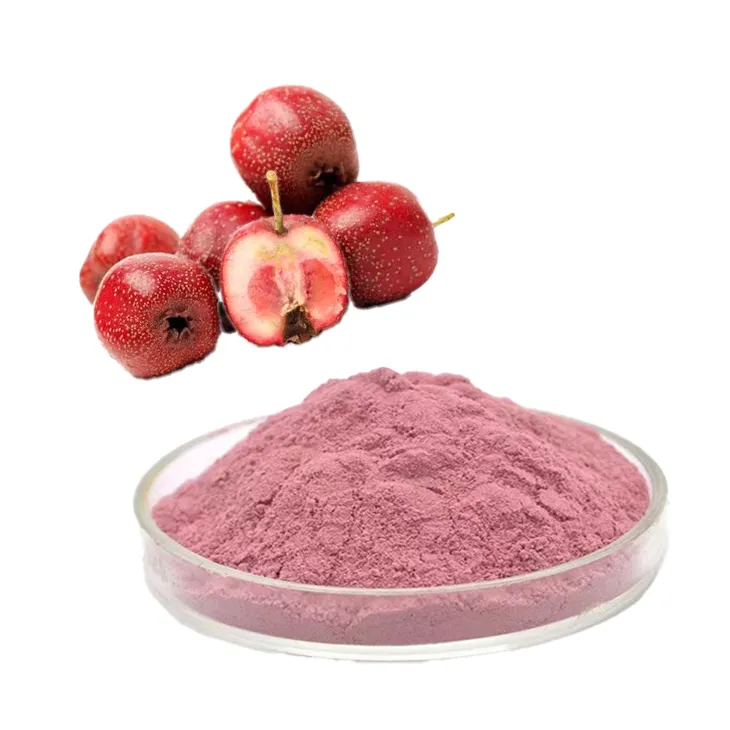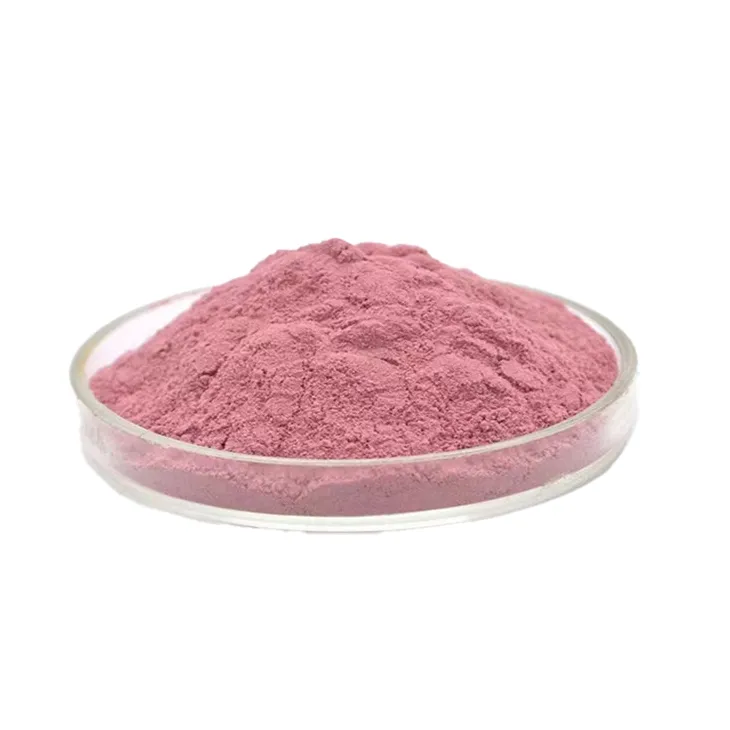- 0086-571-85302990
- sales@greenskybio.com
Active components in hawthorn powder.
2024-11-29

1. Introduction
Hawthorn powder has been recognized for its various health - promoting properties. This is largely due to the presence of multiple active components within it. These components work together synergistically to offer a range of benefits, from improving cardiovascular health to enhancing the body's overall well - being. Understanding these active ingredients is crucial for fully grasping the potential of Hawthorn powder as a natural remedy and a valuable addition to a healthy lifestyle.

2. Flavonoids in Hawthorn powder
Flavonoids are one of the prominent active components in hawthorn powder. They are a diverse group of polyphenolic compounds that are widely distributed in plants.
2.1. Chemical Structure and Properties
The chemical structure of flavonoids is characterized by a 15 - carbon skeleton, which typically consists of two benzene rings connected by a three - carbon bridge. This structure gives flavonoids their unique physical and chemical properties. They are often responsible for the color of plants, and in the case of hawthorn powder, they contribute to its characteristic hue. Flavonoids can be further classified into different sub - groups, such as flavones, flavonols, and flavanones, each with their own distinct chemical and biological properties.
2.2. Anti - Inflammatory Effects
One of the most important functions of flavonoids in hawthorn powder is their anti - inflammatory activity. Inflammation is a natural response of the body to injury or infection, but chronic inflammation can lead to various diseases, such as cardiovascular diseases, arthritis, and certain cancers. Flavonoids exert their anti - inflammatory effects through multiple mechanisms.
- They can inhibit the activity of enzymes involved in the production of inflammatory mediators, such as cyclooxygenase (COX) and lipoxygenase (LOX). By blocking these enzymes, flavonoids reduce the synthesis of prostaglandins and leukotrienes, which are key players in the inflammatory process.
- Flavonoids also have the ability to scavenge free radicals. Free radicals are highly reactive molecules that can damage cells and tissues, and their accumulation can trigger an inflammatory response. By neutralizing free radicals, flavonoids help to prevent oxidative stress - induced inflammation.
- Furthermore, flavonoids can modulate the immune system. They can regulate the activity of immune cells, such as macrophages and lymphocytes, preventing an over - active immune response that can lead to excessive inflammation.

3. Triterpenic Acids in Hawthorn Powder
Triterpenic acids are another important class of active ingredients in hawthorn powder. These compounds have been the subject of extensive research due to their potential health benefits.
3.1. Chemical Structure and Classification
Triterpenic acids are characterized by a 30 - carbon skeleton, which is composed of six isoprene units. They can be further classified into different types based on their structural features. In hawthorn powder, common triterpenic acids include ursolic acid and oleanolic acid.
3.2. Lipid - Lowering Effects
The presence of triterpenic acids in hawthorn powder has been associated with lipid - lowering effects, which is of great significance for maintaining cardiovascular health.
- Triterpenic acids can interfere with the absorption of dietary cholesterol in the intestine. They can bind to cholesterol molecules, preventing their uptake by the intestinal cells and thus reducing the amount of cholesterol that enters the bloodstream.
- These acids also have an impact on the metabolism of lipids within the body. They can enhance the activity of enzymes involved in the breakdown of triglycerides, such as lipoprotein lipase. By promoting the hydrolysis of triglycerides, triterpenic acids help to lower the levels of triglycerides in the blood.
- Furthermore, triterpenic acids can influence the synthesis of cholesterol in the liver. They can regulate the expression of genes involved in cholesterol biosynthesis, reducing the production of cholesterol in the liver and thereby contributing to a decrease in overall blood cholesterol levels.

4. Phenolic Compounds in Hawthorn Powder
Phenolic compounds in hawthorn powder are also key active components that contribute to its health - promoting properties.
4.1. Types and Sources
Phenolic compounds in hawthorn include phenolic acids, such as chlorogenic acid, and flavonoids (which have been previously discussed in a different context). These phenolic compounds are synthesized by the plant during its growth and development, and they are stored in various parts of the hawthorn, such as the fruits, leaves, and stems. When the hawthorn is processed into powder, these phenolic compounds are retained and can exert their beneficial effects.
4.2. Immune - Enhancing Potential
The phenolic compounds in hawthorn powder are known for their potential to enhance the immune system. A strong immune system is essential for protecting the body against various pathogens, including bacteria, viruses, and fungi.
- Phenolic compounds can stimulate the production of immune cells. For example, they can promote the proliferation of lymphocytes, which are key players in the adaptive immune response. By increasing the number of lymphocytes, the body is better equipped to recognize and eliminate foreign invaders.
- These compounds also have antioxidant properties, which are closely related to their immune - enhancing effects. By scavenging free radicals, phenolic compounds protect immune cells from oxidative damage. This is important because oxidative stress can impair the function of immune cells and reduce their ability to fight off infections.
- Furthermore, phenolic compounds can modulate the activity of cytokines. Cytokines are small proteins that play a crucial role in the communication between immune cells. By regulating cytokine production, phenolic compounds can fine - tune the immune response, ensuring that it is appropriate and effective.

5. Other Active Components
In addition to flavonoids, triterpenic acids, and phenolic compounds, hawthorn powder may also contain other active components that contribute to its overall health benefits.
5.1. Vitamins
Hawthorn powder may contain certain vitamins, such as vitamin C. Vitamin C is an important antioxidant that can help to protect cells from oxidative damage. It also plays a role in collagen synthesis, which is important for maintaining the integrity of blood vessels, skin, and other tissues. Additionally, vitamin C can enhance the absorption of iron from the diet, which is beneficial for preventing iron - deficiency anemia.
5.2. Minerals
Some minerals may also be present in hawthorn powder. For example, potassium is an important mineral that is involved in maintaining normal heart function. It helps to regulate the balance of fluids in the body and is essential for the proper functioning of nerve cells. Calcium is another mineral that may be present in hawthorn powder. Calcium is necessary for building and maintaining strong bones and teeth, and it also plays a role in muscle contraction and blood clotting.
6. Synergistic Effects of Active Components
The various active components in hawthorn powder do not act in isolation but rather work together synergistically to produce the observed health benefits.
- For example, the anti - inflammatory effects of flavonoids may be enhanced by the antioxidant properties of phenolic compounds. The antioxidant activity of phenolic compounds can help to reduce the oxidative stress that can trigger inflammation, while the flavonoids directly target the inflammatory pathways. Together, they can provide more effective anti - inflammation protection.
- The lipid - lowering effects of triterpenic acids may be complemented by the actions of other components. For instance, the antioxidant and anti - inflammatory effects of flavonoids and phenolic compounds can help to protect the blood vessels from damage caused by high lipid levels. This can prevent the development of atherosclerosis, which is often associated with elevated lipid levels.
- Similarly, the immune - enhancing potential of phenolic compounds may be boosted by the presence of other nutrients, such as vitamins and minerals. Vitamins and minerals are essential for the proper functioning of immune cells, and their combined action with phenolic compounds can result in a more robust immune response.
7. Conclusion
Hawthorn powder contains a rich array of active components, including flavonoids, triterpenic acids, phenolic compounds, vitamins, and minerals. Each of these components has its own unique properties and functions, and they work together synergistically to offer a wide range of health benefits. The anti - inflammatory, lipid - lowering, and immune - enhancing effects of these active ingredients make hawthorn powder a promising natural supplement for promoting overall health. However, further research is still needed to fully understand the mechanisms of action of these components and to explore their potential applications in the prevention and treatment of various diseases.
FAQ:
Question 1: What are the main functions of flavonoids in hawthorn powder?
Flavonoids in hawthorn powder not only contribute to its color but also play an important role in anti - inflammatory functions.
Question 2: How do triterpenic acids in hawthorn powder affect cholesterol levels?
Triterpenic acids in hawthorn powder are associated with lipid - lowering effects, which is beneficial for those concerned about cholesterol levels.
Question 3: What is the role of phenolic compounds in hawthorn powder in terms of health?
Phenolic compounds in hawthorn powder are known for their potential to enhance the immune system, which makes it a potential natural supplement for overall health improvement.
Question 4: Are there other active components in hawthorn powder?
Yes, apart from flavonoids, triterpenic acids and phenolic compounds, hawthorn powder may also contain other active components, but the ones mentioned above are among the most important.
Question 5: How can hawthorn powder be used as a natural supplement?
Hawthorn powder can be used as a natural supplement by adding it to food or drinks. However, it is important to consult a healthcare professional before starting any new supplement regimen.
Related literature
- Analysis of Active Components in Hawthorn"
- "The Health Benefits of Hawthorn and Its Active Constituents"
- "Research on Flavonoids in Hawthorn Powder"
- ▶ Hesperidin
- ▶ citrus bioflavonoids
- ▶ plant extract
- ▶ lycopene
- ▶ Diosmin
- ▶ Grape seed extract
- ▶ Sea buckthorn Juice Powder
- ▶ Beetroot powder
- ▶ Hops Extract
- ▶ Artichoke Extract
- ▶ Reishi mushroom extract
- ▶ Astaxanthin
- ▶ Green Tea Extract
- ▶ Curcumin Extract
- ▶ Horse Chestnut Extract
- ▶ Other Problems
- ▶ Boswellia Serrata Extract
- ▶ Resveratrol Extract
- ▶ Marigold Extract
- ▶ Grape Leaf Extract
- ▶ blog3
- ▶ blog4
-
Organic non - transgenic black rice extract.
2024-11-29
-
High - quality Chasteberry Extract Products.
2024-11-29
-
China's banana juice powder suppliers.
2024-11-29
-
Bulk purchase of cranberry extract.
2024-11-29
-
How to make powder with bayberry extract?
2024-11-29
-
Panax Ginseng Leaf Extract
2024-11-29
-
Lemon Balm Extract
2024-11-29
-
Bayberry Extract
2024-11-29
-
Garcinia Cambogia Extract
2024-11-29
-
Sugarcane Extract
2024-11-29
-
Angelica sinensis extract
2024-11-29
-
Avocado Extract Powder
2024-11-29
-
Oyster Mushroom Extract Powder
2024-11-29
-
Green coffee bean Extract
2024-11-29
-
Propolis Extract Powder
2024-11-29





















